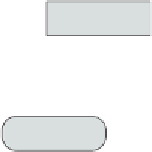Agriculture Reference
In-Depth Information
the PCBs are collected as a liquid for treatment by the BCD process. BCD
is a nonincineration, chemical dechlorination process that transforms PCBs,
dioxins, and furans into nontoxic compounds. In the process, chlorine atoms
are chemically removed from the PCB and dioxin-furan molecules and re-
placed with hydrogen atoms. This converts the compounds to biphenyls, which
are nonhazardous. Treated soil is returned to the landfill and the organics from
the BCD process are recycled as a fuel or disposed off-site as nonhazardous
waste.
Screening,
crushing,
mixing
with H CO
2
Reactor Feed
Stockpile
Excavated
Soil Stockpile
Vent to atmosphere
10 tons hr
-1
3
Carbon Filters
Baghouse
Demister
Rotary Reactor
1 hr @ 644°F
Scrubber
Cyclone
Heat
Exchange
-70%PCB
Clean Soil
Stockpile
Settling
Tank
Dust
Mixing
Tank
Filtrate
Carbon Filters
Stirred Tank
Reactor
2 hr @ 662°F
Catalyst
Filter Press
Filter Cake
Spent Carbon
Treated Water
Tank
Decontaminated Sludge to Off-Site Disposal
Figure B6.2
Base catalyzed decomposition. This is the process recommended to treat PCB-
contaminated soil stored in Warren County, North Carolina.
From: Federal Remediation Technologies Roundtable,
Screening Matrix and Reference Guide
, 4th ed., FRTR,
Washington, DC, 2002.
The cleanup target of 200 parts per billion (ppb) was established by the
working group for the landfill site and was made a statutory requirement by the
North Carolina General Assembly. The EPA cleanup level for high-occupancy
































Search WWH ::

Custom Search